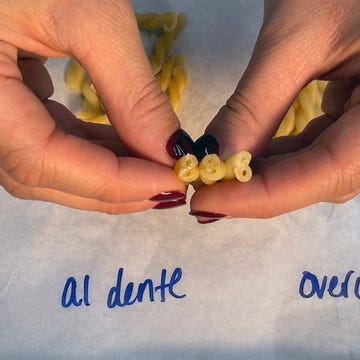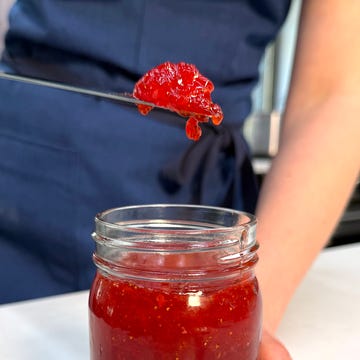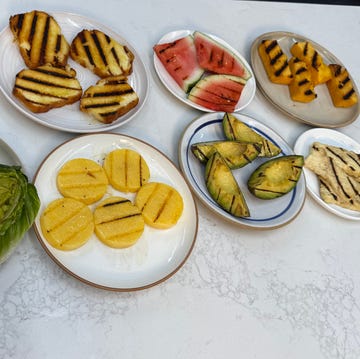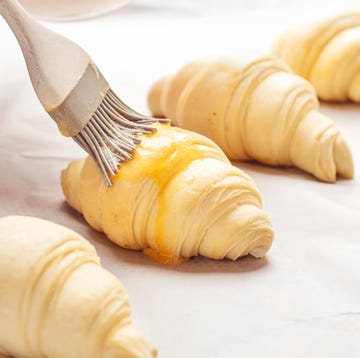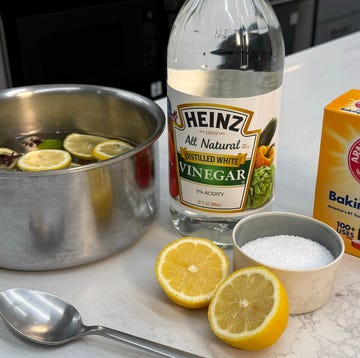There are many reasons to swap out ingredients when following a recipe. Whether you have dietary restrictions, ran out of something in your pantry, or just don’t like an ingredient, the beauty of cooking at home is the ability to adapt.
When making a weeknight dinner or simmering a big batch of soup, many substitutions are fair game. But the opposite is true when it comes to baking. The phrase “baking is a science” isn’t an exaggeration; every ingredient serves a necessary function to the taste and structure of the finished product. Everything from the techniques to the ratios to the ingredients themselves is specific for a reason.
That being said, the meticulous nature of baking doesn’t mean you can’t substitute at all—you just need to proceed with caution. To make it easier for you, we’re rounding up expert-tested ingredient swaps that you can apply to various baking projects.
Baking Essentials
Baking Powder
You can replicate the rising power of baking powder by introducing an acidic ingredient to baking soda—in this case it’s cream of tartar. If you’re interested in learning more about how these ingredients differ, check out our full guide here.
1 tsp. baking powder = ¼ tsp. baking soda + ¼ tsp. cream of tartar
Baking Soda
Ran out of baking soda? You can get the same lift by using baking powder. Baking powder, however, is less powerful than baking soda; so prepare to add more of the ingredient to achieve the same effect.
1 tsp. baking soda = 1 tbsp. baking powder
Cake Flour
You may be familiar with all-purpose flours, but there are more options in the baking aisle. Cake flour is milled more finely and contains less protein than all-purpose. The lower protein levels mean that less gluten will develop and the finished result will be more delicate and tender.
If a recipe calls for cake flour and you don’t have any on hand, you can swap it in for a combination of all-purpose flour and cornstarch. The cornstarch helps to create structure in baked goods while inhibiting gluten development.
1 c. cake flour = 1 c. (minus 2 tbsp.) AP flour + 2 tbsp. cornstarch
Self-Rising Flour
You won’t find it often in a recipe, but occasionally you may encounter one that calls for self-rising flour. It differs from standard all-purpose flour thanks to the inclusion of baking powder. But there’s no need to buy it for just one recipe. In fact, we recommend using this substitution to prevent a half-empty bag from sitting in pantry purgatory.
1 c. self-rising flour = 1 c.(minus 2 tbsp.) AP flour + 1 1/2 tsp. baking powder + ¼ tsp. salt
Eggs
If we had to choose the MVP of all baking ingredients, it would have to be eggs. They add richness with the yolks and help with browning as an egg wash, but most importantly, their proteins are vital for the structure of your baked goods.
It’s hard to replicate the same effect with other ingredients, so we’d only recommend swapping out eggs in recipes that don’t call for large quantities and if you have no other option.
The substitution you choose will have varying effects on texture and flavor. Carbonated water can add fluffiness, but you’ll miss out on the added richness. Applesauce and mashed bananas can contribute moisture and some structure, but your finished product will be more dense and have a distinctly different flavor.
1 large egg = 1/4 c. seltzer or 1/4 c. unsweetened applesauce or 1/4 c. mashed banana
Semisweet Chocolate
Deciphering all of the different types of chocolate can be difficult—but choosing the wrong one can throw off the sugar levels of your entire recipe. If you’re planning on melting chocolate into a batter or frosting, you can use this swap to transform baking chocolate into a semisweet substitute.
However, we wouldn’t recommend this substitute if a recipe calls for adding chocolate in its solid state, like in a chocolate chip cookie or muffin.
5 oz. semisweet chocolate = 3 oz. unsweetened chocolate + 1/4 c. granulated sugar
Oil
Fat is the key to making your baked goods moist, and recipes regularly lean on neutral oils (like vegetable and canola) as the primary source. You can swap out oil for other liquid fats—but you should be mindful of how those fats affect the overall flavor and texture.
1 c. canola or vegetable oil = 1 c. melted butter or 1 c. coconut oil
Sweeteners
Brown Sugar
Brown sugar gets its signature deep, rich sweetness thanks to molasses. If your brown sugar stash dried up and you need a substitute, just stir some molasses into granulated sugar.
1 c. brown sugar = 1 c. granulated sugar + 2 tbsp. Molasses
Powdered Sugar
Powdered sugar is also known as 10x, which refers to the amount of times sugar is processed. To make your own powdered sugar substitute at home, you just need to blend granulated sugar until it’s a fine powder. You’ll also need to supplement the sugar with cornstarch, which is used in commercial powdered sugar as an anti-caking agent.
1 c. powdered sugar = 1 c. granulated sugar blended until a fine powder + 1 tsp. cornstarch
Corn Syrup
Corn syrup is a type of invert sugar, which is when a compound sugar is broken down into its simple sugar components and becomes a syrup. It works differently than granulated sugar because it retains more moisture and doesn’t crystallize.
DIY-ing your own corn syrup with light brown sugar and water will work in a pinch, but just prepare for some difference in terms of texture (especially after your baked goods sit for a few days).
1 c. corn syrup = 1 1/4 c. light brown sugar + 1/3 c. water
Honey
Like corn syrup, honey is an invert sugar—bees introduce enzymes that naturally break down nectar into monosaccharides. The same disclaimers for corn syrup swaps also apply when it comes to honey. But there’s another consideration worth noting: swapping honey for sugar and water will also sacrifice the naturally floral flavor that comes with the ingredient.
1 c. honey = 1 1/4 c. granulated sugar + 1/4 c. water
Dairy Products
Butter
The base of nearly any baked good starts with butter. If you’re planning on substituting it in a recipe, it’s worth determining the role butter plays in it.
If you’re making a cake or a batch of muffins, you can often swap butter out for vegetable oil. And a bonus: using a fat with no water content means your baked goods will stay moist for longer.
In other cases where you want a fluffier outcome, you can use Greek yogurt instead. Just make sure you’re using whole milk varieties and be aware that your recipe will end up tangier and less rich than the original version.
1 c. butter = 1 c. Greek yogurt or ¾ c. vegetable oil
Heavy Cream
Heavy cream is composed of around 36-40% fat, which makes it far richer than plain milk. If a dough or batter calls for heavy cream, you can swap it for milk supplemented with added butter.
However, you shouldn’t use this substitute in recipes that call for whipping heavy cream. You won’t be able to achieve the same fluffy peaks, which are essential for folding into mousses and dolloping on top of pies.
1 c. heavy cream = ¾ c. whole milk + 3 tbsp. melted butter
Milk
Tried making a recipe only to realize that your milk has soured? We’ve all been there, but that doesn’t mean you need to halt your baking project. All you need to do is reconstitute some evaporated milk with water and you’re good to go.
1 c. whole milk = 1/2 c. evaporated milk + 1/2 c. water
Buttermilk
Buttermilk is a staple baking ingredient for several reasons. Its natural acidity reacts with baking soda to help your recipes rise. That acidity also helps inhibit gluten formation, which gives you a more tender crumb. And, naturally, the tang also lends flavor.
You can replicate the same effects as buttermilk by adding a splash of acid (either lemon juice or white vinegar) to milk.
1 c. buttermilk = 1 c. dairy milk + 1 tbsp. lemon juice or white vinegar
Sour Cream
Sour cream is commonly used in baking projects for the same reasons you’d use buttermilk—with the added benefit of extra milk fat. You can replace sour cream in nearly any baking project by using other tangy dairy products. Make sure to opt for whole milk versions to replicate some of the richness.
1 c. sour cream = 1 c. plain whole milk yogurt






